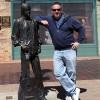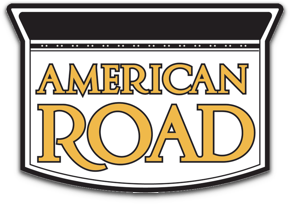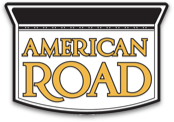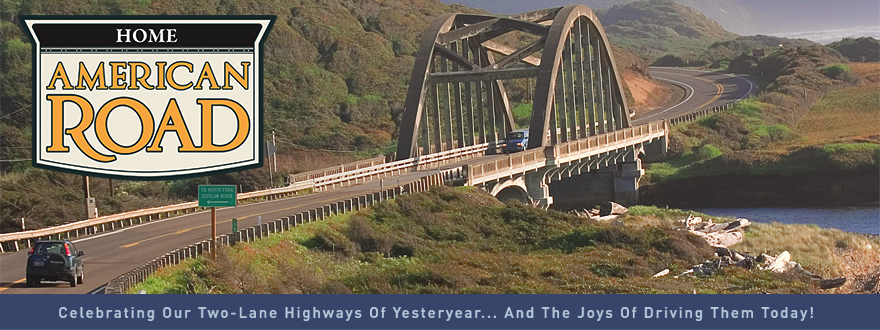-
Posts
447 -
Joined
-
Last visited
-
Days Won
16
roadhound last won the day on July 13 2019
roadhound had the most liked content!
Recent Profile Visitors
The recent visitors block is disabled and is not being shown to other users.
roadhound's Achievements

Roadie (3/6)
29
Reputation
-

My personal Miniature Village
roadhound replied to Dave Reese's topic in Other Roadside Business / Attractions
That's incredible Dave, amazing amount of detail. How many hours did that take or is that something you would rather not think about? Rick -

LH\US 30S between Lyman and Granger Wyoming
roadhound replied to roadhound's topic in Lincoln Highway / U.S. 30 / U.S. 50
Michael, are there any pony truss style of bridges in California? I don't recall ever seeing one. -
Last May, between a day of ceremonies at Promentory, Utah, celebrating the Transcontinental Railroads 150th anniversary and a historic steam engine double-header featuring Union Pacific's Big Boy 4014 and 844 passing through Echo Canyon in Utah I found myself with a day free to do some road explorations in Western Wyoming. Before leaving for the trip I contacted "Greetings from the Lincoln Highway" author Brian Butko for recommendations on what was interesting and worth seeing in the area. One of the many excellent recommendations he made was a section of the Lincoln in Wyoming between Lyman and Granger. Always a sucker for a remote stretch of historic roadway I did my research and put it on my trip itinerary. I left the Interstate prior to Fort Bridger and drove Business 80 through town and on into Lyman. On the east side of Lyman I found the section of dirt road marked by the familiar red, white, and blue sign with the blue "L" on it. From here on it was all dirt road but relatively well maintained and still used regularly. Roadbed leading away from Business 80 east of Lyman After passing through a causeway under the interstate I crossed the first of two pony trusses that pass over Blacks Fork River. The wide open land in this area looked to be used primarily by ranchers and at one point had to make my way through a herd of sheep. I didn’t find a date on the bridges but my suspicion is that they date to sometime during the period when the roadbed was US 30S. Pony Truss bridge across the Blacks Fork River Looking back south and west at the road that was just driven. The second pony truss sits about 4.5 miles further down the road from the first. Pony Truss #2 looking back over the road just driven The next noticeable landmark is the eroded sandstone cliffs of the Church Buttes. It is alleged that the formation was given its name by Mormon pioneers for their steeple-like needles, however, the formation was a significant landmark along the Oregon and California trails as well as the Lincoln and US 30S later on. One report I read stated that there was a service station located across the road from the buttes, which is fitting as the area is now dominated by oil production. Church Buttes Continuing east, the signs of oil production dominate the landscape as you go past an ugly and loud compressor station. At about the 10 mile mark east of the Church Buttes you reach Granger junction, or as it is listed on my 1941 road map, Little America. The junction sat at the intersection of the Oregon Trail and Overland Stage Trail and later was the split between US 30N and US 30S. The town of Granger itself sits a couple of miles to the northwest. Today Little America is a travel center located near the junction of I-80 and the current US 30. The junction at Granger as it is today. The road to the left was the route of the Lincoln and US 30S towards Ogden and the road on the right was US 30N and followed the Oregon Trail to Portland. And the junction as it was in 1927 (Scanned from Brian Butko’s “Greetings from the Lincoln Highway”) A mile and a quarter further east the road intersects with US 30 which can be followed back to the Interstate, past the present day location of the Little America, Green River, and points east. Roadhound http://rick-pisio.pixels.com http://www.rwphotos.com
-
Back to business. One piece of roadside architecture that symobolized baby boomer car culture of the 50 and 60's, and has been dissappearing from the roadside landscape for quite some time now, is the drive-in movie theater. One reason often given for the demise that started in the 70's was improvements made to the sound systems in the walk-ins. Who wanted to watch Star Wars and listen to it through a single speaker hanging from the driver's window when you could see it indoors in Dolby Stereo? The remaining drive-ins have made some improvements by broadcasting the movie audio via FM but for most of the sites their fate was sealed long ago. While the sound system may have been a factor I believe the real reason for their demise was the value of the land they sat on. When they were first built they were in a location away from the center of town, but as cities grew and expanded they gobbled up the land around the drive-in and eventually the drive-in itself. Today there are only 348 operating drive-ins nationwide, which is down from around 4000 in the 1950's. One statistic I would be interested in seeing was what percentage of the baby boomer generation, and the Gen X generation that followed, were concieved in the back seat of a car at a drive-in? The Motor Vu pictured below is located in Riverdale, Utah. Rick http://rick-pisio.pixels.com http://www.rwphotos.com
-
Dave, The social media apps themselves don't bother me as a concept, I've even seen some good things come out of it, but what bothers me is what is done with the data that gets collected. Combine the data collected by FaceApp (Russian) with AI and it has the potential of creating a lot of havoc in our reality. The Pony Express may have collected some very rudimentary data about it's clients but its nothing compared to what Facebook users give up about themselves voluntarily. Rick
-
Thanks Dave, I sincerely appreciate the kind words. I have had a couple of photos in issues of American Road in the past, usually in the letters section. However, if the editors decide to heed your advice I'm not that hard to find. I am grateful that the good folks at American Road magazine keep this forum up and running. In a world where everyone has moved to Facebook, Twitter, Snapchat or other social media it's nice to have this refuge where you can actually converse about a topic with others that have a similar interest in a respectful manner and not worry about some troll hijacking it. I have gained so much knowledge over the years from contributors like yourself that are willing to share what they know and actually seem to enjoy helping to research the things that they don't. Rick
-
The Service Bay Need emergency repairs while on that road trip? Broken fan belt? Leaking radiator? Replace a tire? Those services where once available at most gas stations along your route. The service bay was where the work would take place and if it required the mechanic to get to the vehicles underside then there was the hydraulic lift in the center of the shop to raise the vehicle. Today, a stop for fuel requires you to pump your own gas and emergency repairs, well, good luck with that. The service bay pictured below was once part of a Sinclair station in James Town, Wyoming. Roadhound http://rick-pisio.pixels.com http://www.rwphotos.com
-

Mystery Coupe in Echo Canyon
roadhound replied to roadhound's topic in Lincoln Highway / U.S. 30 / U.S. 50
Dave, Glad you are enjoying my attempt at putting words to a picture. Maybe next time I will tell you the story of how I met a gentlemen named Piggy Malone standing beside the railroad tracks not too far east of where the photo of Elmer and Mable's Plymouth was taken. I thought of going the Bonnie and Clyde route with it but then I would have to come up with the whole backstory for Big Nose Mable and explain how she could go from zero to sixty in less than a minute. Your muscle cars and mine were a bit different. My era had 289's, 302's & 454's although by the time I got my license the first gas crisis had already hit and I couldn't afford the gas for any of them. I am a bit confused on the deuce and a quarter, wouldn't that be 225hp? Rick -

Mystery Coupe in Echo Canyon
roadhound replied to roadhound's topic in Lincoln Highway / U.S. 30 / U.S. 50
I think the old timers name was Ezekiel or Jebediah or something like that. His burro was hitched to the post outside. -

Mystery Coupe in Echo Canyon
roadhound replied to roadhound's topic in Lincoln Highway / U.S. 30 / U.S. 50
Outstanding! I thought it was a Plymouth or a Dodge but the only good view I could find was of a Dodge and the forward rake of the doorpost didn't look right. Now that we know what it is we have to figure out how it got there. I heard a story told by an old timer sitting in the corner of the bar in Ogden that may answer that very question. The Legend of Elmer Lockwood He grew up on a farm in Oklahoma during the depression, the 6th of seven children. He served his country during the second world war but wasn't a good soldier. His Army buddies call him "Screwball." He set the record for hours of KP duty in his division. When he got back he was unable to hold a job and suffered today from what we would call PTSD. It was raining hard on the day before Christmas Eve in 1949 when he got in his '46 Plymouth 2 door Deluxe Sedan and headed up Weber Canyon to the small town of Morgan to rob a bank. During his escape he lost his bearings and got turned around in the hard blowing snow . Instead of heading west to the flat, open, land surrounding the Great Salt Lake he headed east, further into Weber Canyon. That limited him to 2 options; head south on the old Lincoln Highway towards Coalville and back towards the Great Salt Lake or head east, towards Evanston and wide open Wyoming. He figured they would be waiting for him in Coalville and hoped that the Wyoming State Troopers hadn't been alerted yet. East it was. As he sped through the town of Echo he could see 2, maybe 3, Utah Troopers in his rear view mirror about a half mile back. He turned east and headed up Echo Canyon Road, right foot pushing as hard as it could into floor trying to get all he could out of the 217 cubic inches under the hood. Would the 95HP be enough? The Troopers were gaining on him. Six miles into Echo Canyon, on a long straight stretch he lost traction on a patch of ice and felt the the rear end skid out the right. He slid sideways off the road and down the embankment finally coming to a stop on the bank of Echo Creek. He tried to start the motor but it wouldn't turn over. Trying to make one last stand he grabbed his handgun, pulled on the door handle, but before he could get out of the car the Troopers filled the door of the Plymouth with holes. The police left the car where it landed and in time the creek bed built up around it leaving just enough exposed to frustrate anyone who tried to figure out what it was and how it got there. The locals say that on a snowy winters night, on the eve of Christmas Eve, if you stand beside the car you can hear the ghost of Elmer Lockwood tell you "it's a 1946 Plymouth 2 door Deluxe Sedan." -

Mystery Coupe in Echo Canyon
roadhound replied to roadhound's topic in Lincoln Highway / U.S. 30 / U.S. 50
Thanks mga707 for taking the time to look through your encyclopedia. My thoughts in regard to the age of the vehicle were along the same lines. The car is way before my time but I have read that post war models varied little from their pre-war predecessors. After spending an hour or so googling different makes and years my best guess would have to be a late 40's Plymouth or Dodge, although I haven't yet found anything that matches exactly. -
Recently, I was driving the Lincoln Highway through Echo Canyon and spotted an unusual sight just to the south of the roadbed. Toward the eastern end of the canyon, down a 10 foot embankment, and across a small creek was the remains of what looked to me like a 1940's era coupe. The paint was faded, there were bullet holes in the door, and it was half submerged in the soil. As I hiked down to get a closer look a number of questions popped into my head. What year, make, and model is it? How did it get there? How long has it been there? Was it the sight of a shootout between police and bank robbers? The water in the creek was to wide for me to leap across and short of ripping out a fencepost I couldn't find a suitable material to make a bridge, so, I was left to making my observations from a distance. I was able to see that all the glass was missing with the possible exception of a tail light on the drivers side. It didn't look like the steering wheel or much of the interior was intact but it was difficult to tell with it being submerged in the soil the way it was. I did observe a small piece of the rear bumper sticking up out of the earth which leads me to believe that the frame is intact. If anybody knows the story of this relic I would be interested in hearing about it. Roadhound http:\\rick-pisio.pixels.com http:\\www.rwphotos.com
-
After giving the Mom & Pop Motel guide a little bit of thought I believe that it has to be a phone app with a VR tour. I've seen a few of the high end hotels offer a virtual reality tour on their websites now and I think being able to walk through a motel and check out the room before even stopping to take a look would be beneficial to those mom & pops that are clean and comfortable looking. Of course, there may be a VR marketing angle to be found for the seedier motels too, but I digress. Imagine if you could pull up Main St. in Anytown on Google maps, click on the motel that looks interesting from the street view, and then walk into the rooms and around the grounds before your trip even starts. It wouldn't eliminate looking at the room before you signed in but at the least you would have a good idea what it was like before you got there and could eliminate the less desirable motels from the start. Roadhound
-
Geez, I leave for a couple of days and come back to arachnid flashbacks, mutant cattle, and fond remembrances of thousand finger massages. My parents never gave me the quarter so I'll never know the euphoria that a thousand finger massage can bring. For the record it was my younger brother that wanted a pool, my desire was a restaurant nearby not only so that we didn't have to drive any more but also so that I could get a hamburger and fries. I don't know why it was but hamburgers on a road trip were always bigger, juicier, and tastier than anything I could get at home. It didn't matter what town we happened to stop in it was always the case. MGA707's comments about the Mom & Pop motel in New Mexico reminded me of our stay at the Blue Swallow Motel in Tucumcari. It had all of the warmth of a good bed & breakfast (without the potpourri) along with the nostalgia of 50's roadtrip. The room we had was immaculately restored and clean, clean towels and bed linens, plus modern conveniences like wifi and flat screen TV's. The rate was extremely reasonable, if I recall, and the person I gave the credit card to when we checked in was the owner. It captured the nostalgia of the era with modern convenience thrown in. My wife was so impressed she forgave me for the machete adventure on our way to Montoya earlier in the day. I know of a few Mom & Pop type motels that have been restored and are operating but they are mostly along Route 66. Besides the Blue Swallow the Munger Moss in Missouri, the El Trovatore in Kingman, and the Wigwams in San Bernardino and Holbrook come to mind. I wonder if there is much of a market for that type of road trip motel nostalgia outside of the Route 66 corridor? Roadhound
-
Thanks Dave, I always enjoy and appreciate your comments. I bet you've got a lot of great photos in that archive of yours. Do you recall what film your father was shooting back in the day? I hope it was Kodachrome because then there is a good chance that the slides still have an image on them. Some of the comments that I add to go along with the photos are from the perspective of a man now in his 50's recalling what he remembers of the vacations with his parents and imagining the experience from his parents perspective based on his own experience years later with his own family...if that makes any sense. As a kid in the late 60's and early 70's I certainly remember coming into a town's main street late at night, after driving all day, and passing by the motels all lit up with neon. Mine and my brother's first reaction was always to the sign, sometimes dad would pull in and other times it was "no, not that one." We had other criteria too. My brother wanted a swimming pool, I wanted a resturaunt nearby, and mom just wanted it to be clean. Typically we would pull into the parking lot and my dad would get out and ask to see a room while we waited in the car. Sometimes we would stop at 3 or 4 motels before he found one that he was comfortable with, and my dad isn't a picky person. Sometimes we would have to take what was available and make the best of it. My last vacation as a passenger in my parents car was in 1978, by then they would look first to the major chains. By the time I was traveling with my family in the late 90's through the 00's I would look to the chain motels as well. By then the mom & pop motels were pretty rundown and not desirable for a family. By the time we took our last trip as a family in 2012 we had settled on one or two major chains. The Best Western chain seemed to be preferred, the rates were reasonable and they provided a free breakfast. When your doing a 2 week drive saving $20 or $30 a day on breakfast for a family of 4 adds up. Rick




